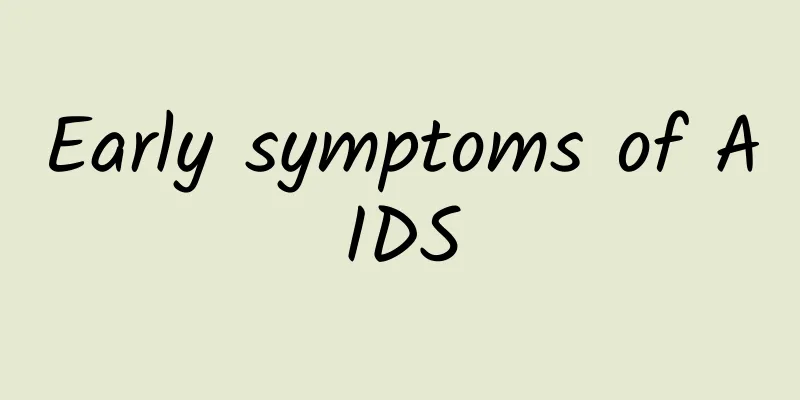Early symptoms of AIDS

|
In our lives, we often encounter public service advertisements promoting AIDS prevention. AIDS is quite scary for the human body because it can cause serious damage to the human immune system. Once contracted, it is easy to be infected by other viruses. There is currently no effective treatment for AIDS, only appropriate control of the disease. The early symptoms of AIDS are something we should all know. Everyone should be familiar with AIDS, because schools or street offices often publicize knowledge about AIDS and teach everyone how to prevent the occurrence of AIDS. So everyone should know the early symptoms of AIDS. symptom 1). Acute infection period: After being infected with HIV, HIV stimulates the body to cause an immune response. After that, there will be a relatively healthy asymptomatic infection period of varying length. Clinical symptoms: Some patients experience transient infectious mononucleosis-like symptoms. The onset is sudden, with symptoms such as fever, sweating, headache, sore throat, nausea, anorexia, general malaise, and joint and muscle pain. It may also be accompanied by erythematous rash, vomiting, diarrhea, generalized lymphadenopathy or thrombocytopenia. Some also develop acute aseptic meningitis, manifested by headache, neurological symptoms and meningeal irritation. Peripheral blood examination: total white blood cell count is normal, or lymphocytes are decreased and monocytes are increased. Lymphocyte subset examination showed no significant changes in the CD4/CD8 cell ratio. This period lasts for a week or two. Because the symptoms during this period are non-characteristic and mild, they are often misdiagnosed as a cold and ignored. Serum HIV antibodies may show a positive reaction 2 to 6 weeks after infection. 2). Asymptomatic infection period: During this period, in addition to positive serum HIV antibodies, the number of T cells in the infected person may progressively decrease. But the virus continues to replicate and those infected are already contagious. Clinical symptoms: None. Duration: There are large individual differences, and it is now believed to be 2 to 10 years, generally 6 to 8 years. This makes it very difficult to detect patients early and prevent the disease. 3). The early stage of acquired immunodeficiency syndrome is also known as "persistent generalized lymphadenopathy syndrome (PGLS)", "AIDS-related complex (ARC)", etc. Clinical symptoms: persistent generalized lymphadenopathy. In addition to the inguinal lymph nodes, two or more lymph nodes in other parts of the body are enlarged, with a diameter of 1 cm, which lasts for more than 3 months. The lymph nodes are mostly symmetrical, firm to the touch, can move freely, are not tender, and do not respond to general treatment. It is often accompanied by fatigue, fever, general malaise and weight loss. Excluding other causes, the disease can be diagnosed as belonging to this stage. In some cases, the swollen lymph nodes may disappear after more than a year, but they may swell again. About 30% of patients may only have superficial lymphadenopathy without other systemic symptoms. Some patients experience headaches, depression or anxiety, some develop lesions of sensory nerve endings, and even have neuropsychiatric symptoms such as reactive mental disorders, which may be related to the virus invading the nervous system. Some patients already have signs of immunodeficiency. In addition to the above-mentioned superficial lymphadenopathy and systemic symptoms, they also repeatedly experience various specific or recurrent non-fatal infections. However, in recent years, many scholars have advocated the abolition of the pre-stage of acquired immunodeficiency syndrome and the classification of lymphadenopathy and other symptoms into the asymptomatic infection period, but some systemic manifestations are classified into the acquired immunodeficiency syndrome period. 4). Acquired immunodeficiency syndrome Clinical symptoms: In addition to the characteristics of the early stage of acquired immunodeficiency syndrome, there may be obvious fever, fatigue, night sweats, uncontrollable weight loss (10%), persistent diarrhea, persistent fever (38°C) for more than 3 months, etc.; and severe clinical manifestations of immunodeficiency, such as slow cellular immune response, opportunistic infections and malignant tumors, which can affect all systems and organs of the body, and often multiple pathogens cause coexistence of infections and tumors. The above is an introduction to the knowledge about the early symptoms of AIDS. I hope it can arouse everyone’s vigilance. If you find yourself feeling unwell, you should go to a regular hospital for examination and treatment in time, because early treatment is very helpful in controlling the AIDS condition. At the same time, everyone must pay attention to this disease in their lives. |
<<: Precautions for Chinese medicine enema
Recommend
What causes myocardial ischemia? Three causes are at work!
The incidence of myocardial ischemia is increasin...
How to treat oral herpes? You can start from two aspects
The appearance of herpes at the corners of the mo...
Precautions after hysteroscopic adhesion surgery
Hysteroscopic adhesion surgery is a relatively co...
How to care for breasts during late pregnancy?
Pregnancy requires special care for women, and ca...
The secret recipe of nourishing kidneys with ears without spending a penny works every time!
According to the Five Elements Theory of Traditio...
How many years can you live with a cystostomy?
Cystostomy is also a relatively common method. It...
What to do if hemiplegia caused by cerebral hemorrhage
Cerebral hemorrhage is what we call "stroke&...
Symptoms of pulmonary edema, most commonly acute pulmonary edema
Common causes of pulmonary edema include infectio...
Is athlete's foot related to gynecology?
Athlete's foot can be said to be a very commo...
Is yellow urine normal during pregnancy?
Women who have had pregnancy experience may have ...
How to treat people with Qi and blood deficiency
Due to their unique physiological structure, wome...
How to recover quickly from tailbone pain
Although the coccyx is not an essential structure...
The efficacy and function of the root of five-fingered peach
The root of the five-fingered peach mainly has th...
Chinese herbal formula for seborrheic alopecia?
Seborrheic alopecia is also known as premature ba...
Is proteinuria in nephrotic syndrome serious? what to do?
Nephrotic syndrome is a common disease in life. T...









